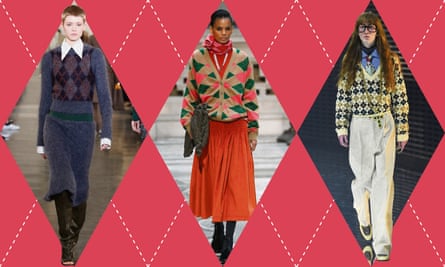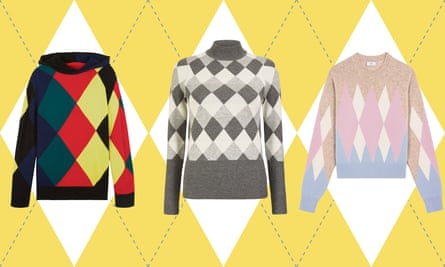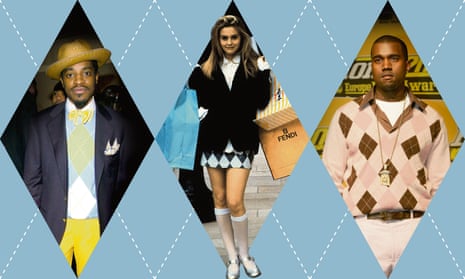A different view on an established classic is a familiar trick in fashion – take shoulder-robing your coat or french-tucking a shirt, for example. And consider argyle: the diamond pattern came into being by looking at something another way – in this case, tartan in the 17th century.

“Clans used to weave tartan on smaller frames to make tartan hose,” says Professor Alistair O’Neill, a fashion historian and writer, Central St Martin’s college in London. “They found it wasn’t particularly form-fitting so they turned it 90 degrees. They worked out that if you cut the fabric once it is woven on the bias, it gives it a certain elasticity. So by turning tartan on its side you get argyle.”
Argyle’s diamond pattern – those squares of tartan turned 90 degrees – is a classic, but it’s emerging as a jumper of choice this winter. It appeared in various guises on the catwalk. It was seen at Gucci (a bit Wes Anderson), Victoria Beckham (smart, put-together), Molly Goddard (a relaxed fawn and emerald cardigan), Chloé (graphic, a bit conceptual) and Polo Ralph Lauren (classic preppy). There are affordable options, too, ranging from Marks & Spencer to Stussy and Ami.
For many, Pringle “owns” argyle. The Scottish label has produced it since the 1920s, and is famous for dressing the Duke of Windsor. Now, though, argyle’s fashion moment is attracting a very different kind of fan. The brand recently launched Pringle Reissued, a Generation Z-targeted range that features Lennon Gallagher, Jess Maybury and Palace model Lucien Clarke in the ad campaign. That street-style take on argyle, says Pringle’s creative director, Fran Stringer, “is in the air. Burberry brought back the bucket hat and the check,” she says, adding that the collection was inspired by argyle from the late 80s and early 90s.
If the 90s is one influence on Generation Z, so is a slightly fogey-ish tweedy look that Hugo Harris, senior manager of Beyond Retro, the online vintage store, pegs to many Generation Z-ers watching The Crown. “I think the idea of heritage and tradition is coming back,” he says. “Designers are referencing the idea of traditional dress from country walks to royals or the idea of ‘punk.’ With The Crown pulling the royal family’s past back into the present, this has had a huge social impact.” You don’t need the budget of a Windsor, though – the vintage site’s countless argyles all come at less than £30.

As much as there is an association with aristocracy and heritage, argyle’s meanings are numerous in 2019. That is why it chimes perfectly with a generation that likes nothing more than picking and choosing references and putting them together. Stringer’s moodboard for the Reissued collection featured images of Begbie from Trainspotting and 80s football casuals wearing designer labels. The casuals would have picked up on those sweaters from golf – a sport associated with the well-off and a lifestyle that was perhaps seen as aspirational for a largely working-class demographic. Pringle collaborated with Nick Faldo in the 80s on a range so popular that, by the end of the decade, the brand was producing 10,000 sweaters a week – Stringer points out that these originals can now be picked up on eBay.

Casuals would also have been influenced by the argyle pattern’s place in the American preppy look. Like the Harrington jacket (which hails from Manchester), argyle was made in the UK, popularised in the US and sold back to Britain with American allure. O’Neill points to argyle at Brooks Brothers in the 50s, with shops at Harvard and Yale universities. By the 90s, the preppy dresser was gently mocked by characters such as Carlton Banks in The Fresh Prince of Bel-Air and Cher Horowitz in Clueless, both of whom wore argyle.
But if preppy style was the preserve of rich kids, such as Banks and Horowitz, it has also been part of hip-hop culture since the 80s. Young people of colour, typically from poorer US urban centres were, like the casuals, subverting an elite classic. Eric Arnold, a hip-hop historian and consultant on Oakland Museum’s 2018 exhibition Respect: Hip-Hop Style & Wisdom, describes the look as the contrast between a “sort of the Brett Kavanaugh reality”, in which preppy was traditionally seen to belong, and that of groups such as the Lo-Lifes, the Polo Ralph Lauren obsessives in Brooklyn, New York City, who would often steal clothes from department stores. “They had a degree of street credibility which is out of reach for an average prep school student,” he says.
“It was this tradition that saw Andre 3000 and Kanye West circa The College Drop Out album wearing argyle in the mid-00s.”
Argyle could well enjoy a new moment in music soon, too – Khalid wore an argyle sweater for a gig this year, and you could imagine an argyle sweater being included in Tyler the Creator’s alt-preppy GOLF le FLEUR collection. “Argyle has been adopted by so many different subcultures and so many different classes,” says Stringer. “That’s why I think it is so loved in Britain – it’s a royalty to rebellion item.”

Comments (…)
Sign in or create your Guardian account to join the discussion